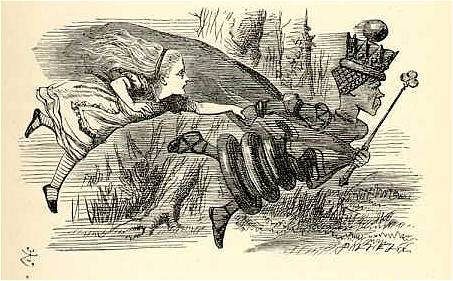The Red Queen was right: life must continually evolve to avoid extinction
June 22, 2013

“It takes all the running you can do, to keep in the same place,” the Red Queen told Alice (illustration by Sir John Tenniel from Lewis Carroll’s Through the Looking-Glass, 1871, credit: Wikimedia Commons)
A University of California, Berkeley study has found that a lack of new emerging species contributes to extinction over a period of millions of years.
The researchers studied 19 groups of mammals that either are extinct or in decline from a past peak in diversity, as in the case of horses, elephants, rhinos and others.
The “Red Queen” hypothesis
The study was conducted by Charles Marshall, director of the UC Berkeley Museum of Paleontology and professor of integrative biology, and former UC Berkeley post-doctoral fellow Tiago Quental. It was designed to test a popular evolutionary theory called the “Red Queen hypothesis,” named after Lewis Carroll’s character who, in the book Through the Looking-Glass described her country as a place where “it takes all the running YOU can do, to keep in the same place.”
In biology, this means that animals and plants don’t just disappear because of bad luck in a static and unchanging environment. Instead, they face constant change — a deteriorating environment and more successful competitors and predators — that requires them to continually adapt and evolve new species just to survive.
“Each group has either lost, or is losing, to an increasingly difficult environment,” Marshall said. “These groups’ demise was at least in part due to loss to the Red Queen — that is, a failure to keep pace with a deteriorating environment.”
The animal groups were initially driven to higher diversity until they reached the carrying capacity of their environment, or the maximum number of species their environment could hold. After that, their environment deteriorated to the point where there was too much diversity to be sustained, leading to their extinction.
“In fact, our data suggest that biological systems may never be in equilibrium at all, with groups expanding and contracting under persistent and rather, geologically speaking, rapid change,” he said. “The findings should help biologists understand the pressures on today’s flora and fauna and what drove evolution and extinction in the past.”